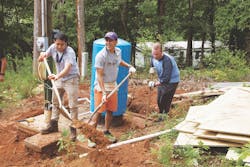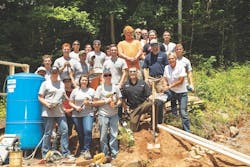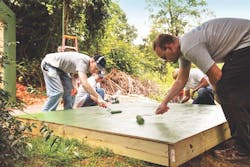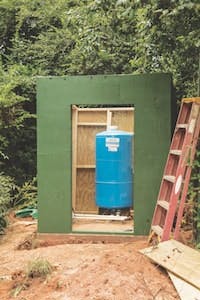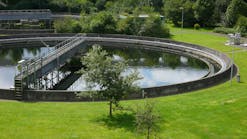Jamie Saxe is senior director for Xylem Watermark & Corporate Social Investment. Saxe can be reached at [email protected].
When Carol Gibson, president of the Holly Ridge homeowners association in Candler, N.C., contacted the Water Well Trust (WWT) in January 2018, the subdivision’s well houses and well equipment had fallen into severe disrepair. The 24 households served by the wells—including 45 adults and 18 children—were left with either poor quality water or no water at all.
“We can’t use the water to drink or cook. I don’t even like to bathe in it. It smells and it’s dirty,” Gibson told the WWT, a nonprofit arm of the Water Systems Council (WSC), established to provide wells for Americans who do not have a safe drinking water supply.
Although the Holly Ridge homeowners association had attempted to maintain the neighborhood well systems, limited finances and knowledge thwarted proper upkeep. Upon inspection, it was discovered the wells did not have a filtering system and pipes were not properly insulated to prevent freezing during the winter. The practice of pouring bleach down the pipes to disinfect the systems further harmed well components, and sediment buildup contributed to poor water quality.
“The homeowners attempted Band-Aid solutions over the last few years, purchasing pumps and tanks from retail stores that quickly failed because they weren’t meant to support that many houses and the setup wasn’t done properly,” said Susan O’Grady, Xylem director of marketing, residential and agriculture, and an active member of the WSC.
Shortly before the Holly Ridge homeowners association reached out to the WWT, O’Grady had approached the organization about collaborating on a project through Watermark, Xylem’s corporate citizenship program. O’Grady had heard Margaret Martens, executive director of the WWT, make a presentation about the WWT during a Goulds Water Technology Distributor Council meeting in late 2017.
“I asked Margaret if there was an opportunity to work together with a distributor and one of our local offices,” O’Grady said. “She reached out to us about a month later after getting a call from a resident of Holly Ridge.”
Holly Ridge seemed like a good fit from the start. As the largest project the WWT has undertaken to date, the project required a team effort.
Landscape & Water Pressure
Because the Holly Ridge neighborhood is located in a remote, hilly area, hooking into the municipal water supply would have been difficult and cost-prohibitive for homeowners. Martens said the cost savings to homeowners in rural areas who drill a new well versus hooking up to a municipal water supply is estimated to be as much as 85%.
Along with Xylem, Dustin Merrill, owner of Merrill Drilling & Water Resources, helped design and build the new water well systems. When water pressure issues proved complicated, Merrill and Chris Preston, residential water product manager for Xylem AWS, collaborated to troubleshoot system issues.
“Multiple trips were made to the job site to uncover issues and determine the best path forward,” O’Grady said.
Chief among those issues was the neighborhood’s rugged terrain, Preston said.
“There were some rather large elevation changes, and given the fact that the wells were already drilled, we needed to select pumps and equipment that could overcome the head and friction loss,” he said.
Low Well Yield Solution
In June, Merrill Drilling removed the existing water well systems, demolished the well houses and installed the new systems. Goulds Water Technology provided all of the materials for the project and supported the WWT with a $1,000 grant through Watermark.
Two wells were outfitted with 18GP2020 ProPak pumps and Aquavar Solo2 variable-frequency drive (VFD) controllers and V350 holding tanks. A 7GP2020 ProPak pump and VFD controller was installed on a third well along with a 1,000-gal buried potable water storage cistern. Crews also laid down more than 1,000 ft of new piping and 2,000 ft of new electrical wiring. Hughes Supply, a Goulds Water Technology distributor in Statesville, N.C., coordinated the transport of the donated pumps and controls to the job site.
“Because higher pressure was required to adequately serve the houses at the higher elevation, we needed to design a system that incorporates higher pressure-rated components, including the transducer and holding tanks,” Preston said.
The third well required the 1,000-gal buried potable water storage cistern because the existing well did not have the capacity or recovery to maintain the proper supply during peak usage. The storage tank acts as a buffer so the well can be pumped at a slower and more continual flow rate, Preston added.
Low well yield, which is typical of the Appalachian region, also prompted the decision to install VFDs and large holding tanks. Before the system was replaced, one of the Holly Ridge wells had been drilled nearly 600 ft deep, but only produced
2 gal of water per minute.
According to Preston, Holly Ridge’s previous fixed-speed water well system had a 20-psi pressure drop between the pump cut-in and cut-out pressure. That combined with undersized pumps resulted in low water pressure in all 24 residences.
“In the new system, the pumps and motors are able to speed up and slow down as needed to maintain a 5-psi pressure differential, resulting in higher and more constant pressure for the homeowners even as demand fluctuates,” Preston said.
With the variable-speed drives in place, Merrill said it is now easier for the water well system to keep up with household water pressure demands.
Detecting Dry Well Conditions
In addition to consistent water pressure, the Aquavar Solo2 VFD controllers feature a dry well sensitivity setting, which detects dry well conditions and shuts down the system to prevent damage to the motor and pump.
“The dry well sensitivity setting controls the power level at which the Solo2 detects a dry well fault,” Preston said. “But the more important thing is the dry well feature itself, which shuts the pump and motor down when it detects air being pumped versus water. The feature automatically restarts the Solo2 and monitors if the well has recovered, preventing overheating and wear on the pump and motor.”
After the new well systems were installed, a group of volunteers from the Xylem office in Charlotte, N.C., partnered with Hughes Supply and Merrill Drilling in early July to build three new well houses through Xylem Watermark.
Since 2008, Xylem Watermark has worked to provide and protect safe water resources for communities in need and to educate people about water issues. Along with its six nonprofit partners, Xylem Watermark has provided clean water and sanitation solutions to more than 3 million people in 38 countries.
In 2016, Xylem Watermark launched a service-focused employee engagement program in support of its mission with the goal of logging 100,000 volunteer hours in three years. Having logged more than 56,000 hours in water-related activities over the first two years in their local communities, Xylem employees were on track to achieve that goal by the close of 2018.
“The collective commitment and energy throughout the entire Holly Ridge project truly embodied the Xylem Watermark mission,” O’Grady said.
As a result, Holly Ridge residents have access to safe, clean water again.
